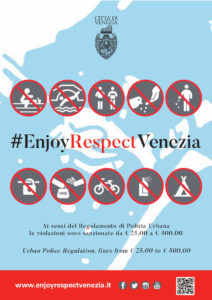Best practices for sustainability
Venice has experienced the good, the bad, and the ugly of tourism – particularly mass tourism. In the last few years the city has taken a number of steps to ensure that tourism is more sustainable and beneficial to the economy as well as the wellbeing of Venetians. Some of the best practices for sustainability implemented by the city include:
The development of a sustainable Venice campaign
Realizing the negative impacts that tourism was having on the port city of Venice, the local tourism stakeholders and the local government came together to form the #EnjoyRespectVenezia. This campaign is aimed at sensitizing tourists arriving in Venice to help make the city sustainable and livable for locals amidst heavy tourism. This followed heavy campaign by locals against the slow death of the city through mass tourism. According to Sustainable Venice this campaign is supposed to
“raise awareness and direct visitors towards adoption of responsible and respectful behavior towards the environment, landscape, artistic beauties and identity of Venice and its inhabitants. The objective if to raise awareness of tourist impact, with the belief that responsible tourism can contribute to sustainable development”
Through this initiative the city of Venice hopes to help visitors create better connections with the city and the local community and have a high quality tourism experience in a natural and built environment that is cared for.
Shift from Mass tourism to Intelligent Tourism
Venice has limited space. It is not surprising therefore that being descended upon by thousands of cruise ships and vessels carrying millions of tourists every year is taking a toll on the beautiful port city. Because of this the city has decided to take a more sustainable approach by shift from mass tourism model to intelligent tourism model. This is being done by employing different techniques to nudge the tourism sectors to encourage more long term visitors over short term visitors. One of the ways the city is doing this is by introducing an entry fee charged for daily entries into the floating city. The city hopes to discourage day-trippers (visitors who only visit for a day) and encourage long term tourists.
Less than half of the 60,000 tourists who visit Venice each day, stay overnight.
Moreover, the introduction of visitor-only walk ways is aimed at reducing the mass emigration of local Venetians from the lagoon by making their life in the city more livable. The aim of this is to bring Venice back to its city status and save it from the theme park image-like image that day-trippers have given it. In this way, the city aims to encourage cultural explorers who will visit Venice for the culture and local people rather than just the physical features.
Behavior control
The local government is putting in place laws and regulations to limit trespassing and rowdy behavior in the city. Outside alcohol consumption (on the streets and parks) and picnicking on stairways around main streets has been banned in the city. Visitors and tourists found engaging in such behaviors are fined and might be prohibited from visiting the city. This is aimed at bringing back the city life to Venice following complaints by local residents of the city government caring more for tourism and revenue from the industry rather than the welfare of the local people. In deed, this complaint is common across major cities where tourism is a major industry. Venice is the first city, however, in Italy to take steps towards encouraging tourists to be considerate of local residents.